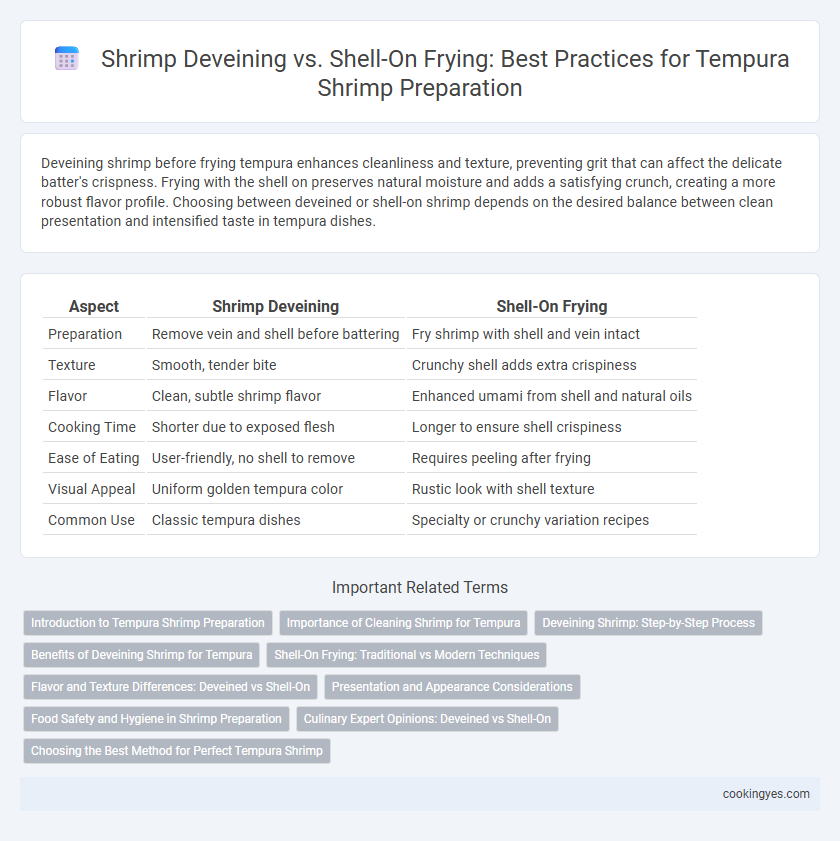Deveining shrimp before frying tempura enhances cleanliness and texture, preventing grit that can affect the delicate batter's crispness. Frying with the shell on preserves natural moisture and adds a satisfying crunch, creating a more robust flavor profile. Choosing between deveined or shell-on shrimp depends on the desired balance between clean presentation and intensified taste in tempura dishes.
Table of Comparison
| Aspect | Shrimp Deveining | Shell-On Frying |
|---|---|---|
| Preparation | Remove vein and shell before battering | Fry shrimp with shell and vein intact |
| Texture | Smooth, tender bite | Crunchy shell adds extra crispiness |
| Flavor | Clean, subtle shrimp flavor | Enhanced umami from shell and natural oils |
| Cooking Time | Shorter due to exposed flesh | Longer to ensure shell crispiness |
| Ease of Eating | User-friendly, no shell to remove | Requires peeling after frying |
| Visual Appeal | Uniform golden tempura color | Rustic look with shell texture |
| Common Use | Classic tempura dishes | Specialty or crunchy variation recipes |
Introduction to Tempura Shrimp Preparation
Shrimp deveining for tempura involves removing the digestive tract, ensuring a cleaner taste and more refined texture compared to shell-on frying, which retains the shell for added crunch and flavor. Proper deveining prevents bitterness and enhances the delicate tempura batter's crispness, while shell-on frying intensifies the shrimp's natural flavors through the shell's aromatic oils. Both methods require precise preparation to balance texture and flavor, crucial for authentic tempura shrimp dishes.
Importance of Cleaning Shrimp for Tempura
Properly deveining shrimp for tempura is essential to remove the digestive tract, which can impart a bitter taste and gritty texture, enhancing the overall flavor and mouthfeel of the dish. While some chefs prefer shell-on frying for added crunch and visual appeal, thorough cleaning ensures food safety and a cleaner taste profile. Meticulous shrimp preparation preserves the delicate balance of tempura's light, crispy batter and the seafood's natural sweetness.
Deveining Shrimp: Step-by-Step Process
Deveining shrimp for tempura involves carefully removing the digestive tract to ensure a clean, mild flavor and improve texture during frying. Begin by peeling the shrimp shell while leaving the tail intact, then use a sharp paring knife or deveining tool to make a shallow cut along the back, extracting the dark vein. Proper deveining prevents bitterness and enhances the shrimp's tenderness, resulting in a crisp, evenly cooked tempura.
Benefits of Deveining Shrimp for Tempura
Deveining shrimp for tempura enhances the texture by ensuring a cleaner bite and preventing any grit or bitterness associated with the digestive tract. Removing the vein also allows for more even frying and better batter adherence, resulting in a crispier, lighter tempura coating. This preparation method improves both the visual appeal and overall eating experience, making the shrimp more enjoyable and refined.
Shell-On Frying: Traditional vs Modern Techniques
Shell-on frying for tempura shrimp preserves natural flavors and adds a crispy texture, essential in traditional Japanese tempura preparation. Modern techniques emphasize precise temperature control and ultra-light batter to enhance the contrast between the crunchy shell and tender shrimp inside. This method maintains the shrimp's moisture while delivering a delicate crunch, highlighting the balance of texture and flavor integral to authentic tempura.
Flavor and Texture Differences: Deveined vs Shell-On
Shrimp deveining for tempura results in a cleaner, more delicate flavor and a tender texture that allows the light, crispy batter to shine. Shell-on frying retains more natural juices and imparts a slightly briny taste, while the crunchy shell adds a contrasting crispy texture. The choice between deveined and shell-on shrimp influences the overall sensory experience, balancing subtle sweetness against an enhanced crunch and deeper umami notes.
Presentation and Appearance Considerations
Shrimp deveining for tempura enhances presentation by providing a clean, visually appealing look with a smooth, golden crust that highlights the delicate texture. Frying shrimp shell-on creates a rustic appearance with crispy shells adding a unique texture and deeper flavor complexity. Presentation choices depend on whether a refined elegance or a bold, textured visual appeal is prioritized.
Food Safety and Hygiene in Shrimp Preparation
Deveining shrimp for tempura enhances food safety by removing the digestive tract, which can harbor bacteria and contaminants, reducing the risk of foodborne illness. Shell-on frying provides an extra layer of protection, minimizing direct contact with the shrimp's flesh and potentially preserving moisture, but it requires careful cleaning of the shrimp's surface to avoid contamination. Proper hygiene during shrimp preparation, including thorough rinsing and using fresh seafood, is essential to ensure safe and high-quality tempura shrimp.
Culinary Expert Opinions: Deveined vs Shell-On
Culinary experts often debate shrimp deveining versus shell-on frying for tempura, highlighting texture and flavor differences. Deveined shrimp provide a cleaner bite and uniform crispiness, while shell-on retains juiciness and adds a subtle briny crunch enhancing the umami profile. Chefs recommend choosing based on the desired dining experience, with deveined shrimp favored for delicate presentation and shell-on preferred for rustic, robust taste.
Choosing the Best Method for Perfect Tempura Shrimp
Shrimp deveining for tempura ensures a clean, grit-free bite and a tender texture, enhancing the overall eating experience. Frying shrimp shell-on locks in natural moisture and adds a crispy, flavorful crunch that complements the light tempura batter. Selecting between deveined or shell-on shrimp depends on desired texture and presentation, with shell-on favored for maximum crunch and deveined preferred for ease of eating and refined taste.
Shrimp deveining vs shell-on frying for tempura shrimp Infographic

 cookingyes.com
cookingyes.com